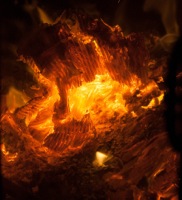Embers
Origin
Middle English eymere, from Old Norse eimyrja; akin to Old English ǣmerge ashes, Latin urere to burn
Definitions
- 1: a glowing fragment (as of coal) from a fire; especially : one smoldering in ashes
- 2: plural : the smoldering remains of a fire
- 3: plural : slowly dying or fading emotions, memories, ideas, or responses still capable of being revived <the embers of his past>
Description
An ember is a glowing, hot coal made of greatly heated wood, coal, or other carbon-based material that remain after, or sometimes precede a fire. Embers can glow very hot, sometimes as hot as the fire which created them. They radiate a substantial amount of heat long after the fire has been extinguished, and if not taken care of properly can rekindle a fire that is thought to be completely extinguished and can pose a fire hazard. In order to avoid the danger of accidentally spreading a fire, many campers pour water on the embers or cover them in dirt.
They are often used for cooking, such as in charcoal barbecues. This is because embers radiate a more constant form of heat, as opposed to an open fire which is constantly changing along with the heat it radiates.
An ember is usually formed when a fire has only partially burnt a piece of fuel, and there is still usable chemical energy in that piece of fuel. Often this happens because the usable chemical energy is so deep into the center that air (specifically oxygen) does not reach it, therefore not causing combustion (carbon-based fuel + O2 → CO2 + H2O + C + other chemicals involved). The reason that it continues to stay hot and does not lose its thermal energy quickly is because combustion is still happening at a miniature scale. The small yellow, orange and red lights often seen among the embers are actually combustion. There just is not enough combustion happening at one time to create a flame. Once the embers are completely 'burned through', they are not carbon as is commonly believed (carbon burns, and is not normally left behind), but rather various other oxidized minerals like calcium and phosphorus. At that point they are normally called ashes. See: Wood ash for more on the residue that is left.
Embers play a large role in forest fires. Since embers are typically burnt leaves and thus small and light, they can be blown away by the wind. During a large fire, with the right wind conditions, embers can be blown far ahead of the fire front, starting spot fires hundreds of metres away. One of the initial stages of defending against a bushfire is dubbed the "ember attack", in which embers will bombard the house, starting small fires in wooden structures.
